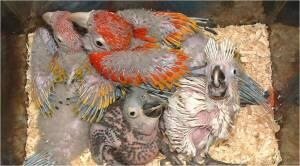How to Set-up a Brooder for your Sick or Young Parrot
I have prepared instructions to make a simple and inexpensive brooder for babies. This brooder can also be used for keeping sick parrots and any other small animals warm.
This style requires three basic parts; Thermometer, box/container, and small baby heating pad.
3 Basic Parts to a Brooder
1. Small heating pads for babies can be found in most department stores. There are also similar heating pads available in medical clinics and stores that cater to athletes.
2. Plastic containers are easy to see through and clean, and usually come with a convenient top. In a pinch you can use a card board box and even a small picnic cooler.
3.Thermometers do not need to be expensive and highly accurate, but they do need to be consistent. Thermometers will be used as a guideline because you will determine the actual temperature setting by the body posture of the baby.
Baby Parrot Brooder 1
Baby Parrot Brooder 2
The easiest and safest method is to place the container ½ over the heating pad so you can have different temperatures available across the bottom of the container.
Several days before you need the brooder you should begin to find the temperature you need. Place the thermometer in the container and move it around to determine how the temperature changes on different parts of the floor. If the temperature is not warm enough you can place the lid on the container and/or wrap the container with a towel. Do not cover the entire top because the babies will need fresh air. As the babies grow it will be less critical to keep the temperature constant.
Always test the heat source at the lowest and highest possible settings to make sure you are aware of how the heat source can change with different settings.
The brooder needs to be placed in an area where there is little or no light and the room temperature is fairly constant.
Insulated Container for small Babies 1
Insulated Container for small Babies 2
Insulated Container for small Babies 3
A second level of temperature control comes from a smaller container where you will place the baby.
A nice comfortable and cozy insulated container for small babies can be made from a cup or bowel and a couple of paper towels. Make a T shape with two lengths of paper towels. Place the cross of the T in the bowel and push to the bottom. For very small babies only push the center of the towels to the bottom making a V-shape so the baby will go to the center of the bottom and stay in the same place all the time. This V in the center will also wrap around the baby similar to a mom or sibling making contact. The V will also help keep the babies feet under him. Without the V a baby may continue to move his feet and develop bleeding sores from the paper towel that seems soft to us but rough to delicate baby skin.
The bottom portion of the T that is sticking out of the bowel can be folded over and turned into a lid.
Comfortable Body Language 1
Proper temperature will be determined by body language but basic guidelines are necessary to get started.
New born babies are the most critical and will need to be kept at ~ 97 Fahrenheit. Over the next few weeks the temperature will slowly drop to ~ 85 until the baby starts to produce feathers. Brooder temperature will be lower when you have several babies in the same container.
Comfortable Body Language 2 Hyacinth Macaw Babies
Comfortable Body Language 3 Macaws and Umbrella Cockatoo
Once you begin observing the baby you should notice body languages the same as you experience when you are warm or cold. Tightly bunched or shivering is too cold and panting is too hot. In the middle you have stretched out comfortable behavior.
Group dynamics can also tell you if the babies are comfortable, Babies stretched out or sitting comfortably next to each other are doing well. If you notice the babies are trying to pile up they are not warm enough.
You can find more details on our website. http://theparrotuniversity.com/arthandfeeding1#brooder
Under Counter Brooder
At Hartman Aviary we have an entire room that is used as a brooder for hundreds of babies a year. Different temperature zones can be found throughout the room. The further away from the heat source under the counter the lower the temperature.
The heater is located under one end of the counter in the corner of the room. By setting the heater temperature correctly we can consistently obtain any temperature in the containers setting on the counter. By the time the heater heats the air under the counter, the wood counter, and the bedding in the container, the temperature will vary little even when the door to the room is opened and cooler air enters.
Sources:
Inexpensive professional brooders
Excellent book about hand feeding.
Parrots: Hand Feeding and Nursery Management September 1, 1992
by Howard Voren & Rick Jordan










